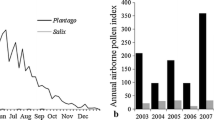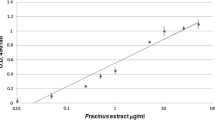Summary
In electron micrographs it could be shown that hazelnut (Corylus avellana) pollen grains are covered on their surface by a diffusible 10 nm thick lamellar layer. On pollen surface as well as in pollen extract this layer could be precipitated and stained by the polycationic dye Cuprolinic blue. By subsequent application of both immunogold labeling with serum from a hay-fever patient allergic to tree pollen grains and histochemical detection with Cuprolinic blue this pollen surface layer proved to be an effective antigen.
Similar content being viewed by others
References
Corbi AL, Carreira J (1985) Distribution of allergen activity and identification of the main IgE-binding glycopeptide of Parietaria judaica pollen. Int Arch Allergy Appl Immunol 76:156–161
De Mey J (1983) Colloidal gold probes in immunocytochemistry. In: Polak JM, Van Norden S (eds) Immunocytochemistry —Practical applications in pathology and biology. Wright, Bristol, p 82
Frens G (1973) Controlled nucleation for the regulation of the particle size in monodisperse gold solutions. Nature (Phys Sci) 241:20–22
Gaude T, Dumas C (1984) A membrane like structure on the pollen wall surface in Brassica. Ann Bot 54:821–825
Grote M, Fromme HG (1984a) Electron microscopic localization of concanavalin A receptor sites in pollen surface material after fixation with glutaraldehyde-cetylpyridinium chloride. J Histochem Cytochem 32:869–871
Grote M, Fromme HG (1984b) Immunoelectron — microscopic localization of diffusible birch-pollen antigens in ultrathin sections using protein-A/gold technique. Histochemistry 81:489–492
Grote M, Fromme HG, Sinclair NJ (1983) The use of cetylpyridinium chloride to preserve water-soluble surface material in pollen for electron microscopy. Micron 14:29–32
Howlett BJ, Vithanage HIMV, Knox RB (1981) Immunofluorescence localization of two water-soluble glycoproteins including the major allergen from the pollen of ryegrass (Lolium perenne). Histochem J 13:461–480
Knox RB, Vithanage HIMV, Howlett BJ (1980) Botanical immunocytochemistry: a review with special reference to pollen antigens and allergens. Histochem J 12:247–272
Reale E, Luciano L, Kühn KW (1983) Ultrastructural architecture of proteoglycans in the glomerular basement membrane: A cytochemical approach. J Histochem Cytochem 31:662–668
Romano EL, Romano M (1984) Historical aspects. In: Polak JM, Varndell IM (eds) Immunolabeling for electron microscopy. Elsevier Amsterdam, p 3
Roth J (1983) The colloidal gold marker system for light and electron micoroscopic cytochemistry. In: Bullock GR, Petrusz P (eds) Techniques in immunocytochemistry, vol 2. Academic Press, London, p 217
Scott JE (1980) Collagen-proteoglycan interactions. Localization of proteoglycans in tendon by electron microscopy. Biochem J 187:887–891
Scott JE, Orford CR (1981) Dermatan sulphate-rich proteoglycan associates with rat tail-tendon collagen at the d band in the gap region. Biochem J 197:213–216
Scott JE, Orford CR, Hughes EW (1981) Proteoglycan-collagen arrangements in developing rat tail tendon. An electron-microscopical and biochemical investigation. Biochem J 195:573–581
Spurr AR (1969) A low-viscosity epoxy resin embedding medium for electron microscopy. J Ultrastruct Res 26:31–43
Vithanage HIMV, Howlett BJ, Jobsen S, Knox RB (1982) Immunocytochemical localization of water-soluble glycoproteins, including group 1 allergen, in pollen of ryegrass (Lolium perenne) using ferritin-labelled antibodies. Histochem J 14:949–966
Völker W, Schmidt A, Buddecke E, Themann H, Robenek H (1985) Binding and degradation of proteoglycans by cultured arterial smooth muscle cells. II. Binding sites of proteoglycans on the cell surface. Eur J Cell Biol 36:58–65
Author information
Authors and Affiliations
Rights and permissions
About this article
Cite this article
Völker, W., Sinclair, N.J., Kalveram, K.J. et al. Is the surface layer from hazelnut pollen, which is precipitated by Cuprolinic blue, an effective antigen in hay-fever patients?. Histochemistry 84, 57–60 (1986). https://doi.org/10.1007/BF00493421
Accepted:
Issue Date:
DOI: https://doi.org/10.1007/BF00493421




